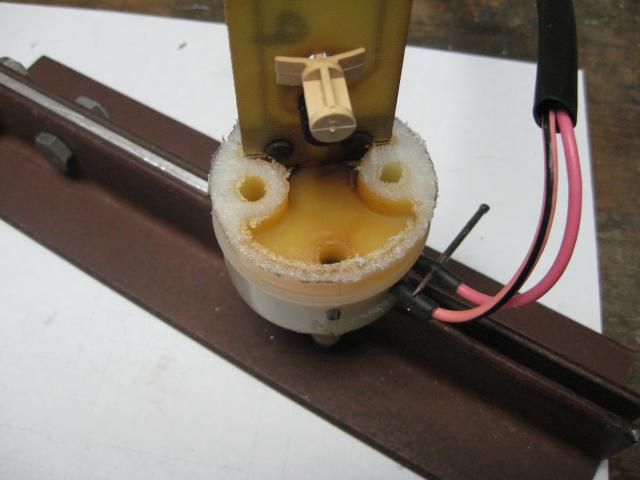Lake Sailor
Active Member
My fuel gauge has been acting up for some time, so while the motor's out of the boat, I thought I'll just fix it.
Floats are a common problem, right? So I check mine, magnets are all on it, floats in gasoline. Not it
Multimeter shows open circuit at the plug. Aha, I says its the old F1 fuse, which I now know about all about from this forum. So I cut into the baffle at what I judge to be the right place:

Surpise! No fuse there. So, I cut another window at the solder lugs:

Now here, the board checks good but still OC at the plug. Turns out, it is OC between that nail thru the pink wire and the solder lug. Can I get to that? Maybe I can dig out what looks to be the potting:

Well, turns out that the thing is made in some kinda multi-step molding process, and this "potting" is about as hard as a rock, or anyway the rest of the baffle :banghead:

At this point, I judge it to be non-repairable. But I continue the forensics, just for the entertainement value. So I saw the whole top off the thing and extract the board intact.

Notice the F1 fuse is located about exactly where the sealing lip or whatever you call it is. Seems to me this would make for a difficult repair by the cut-a-window and plastic weld method. I suggest another repair method for the truly ambitious:
First, saw the whole top off as shown. Second, fix the board as needed. Third, counter drill the two fuel passages in each sawed half,

and insert some stainless tubing or something, with some gas-proof sealer. Fourth re-assemble the baffle, maybe plastic welding the joint. Said completed joint is underneath the rubber boot which attaches the baffle to the tank and is completely invisible without removing the boot. Cool huh? Lemme know how it turns out
So, hows this thing work in the first place? Well the board is a circuit with a bunch of resistors (the short things) along it in what I would say is a series circuit:

And what appear to be a number of magnetic switches (the long things).

As the float travels from the bottom (empty) to the top (full) it apparently closes the switches, shortens the circuit, and decreases the circuit total resistance. You can pass any kind of magnet along the board and watch the resistance change. So there. BTW, many books are written about what I don't know about electronics. So there, again.
Interesting excercise, yes, but by now this baffle is REALLY not repairable. Given the way it went bad, I didn't feel good about a used one. Lucky to find a NOS at a decent price. All's well that ends well
Floats are a common problem, right? So I check mine, magnets are all on it, floats in gasoline. Not it
Multimeter shows open circuit at the plug. Aha, I says its the old F1 fuse, which I now know about all about from this forum. So I cut into the baffle at what I judge to be the right place:

Surpise! No fuse there. So, I cut another window at the solder lugs:

Now here, the board checks good but still OC at the plug. Turns out, it is OC between that nail thru the pink wire and the solder lug. Can I get to that? Maybe I can dig out what looks to be the potting:

Well, turns out that the thing is made in some kinda multi-step molding process, and this "potting" is about as hard as a rock, or anyway the rest of the baffle :banghead:

At this point, I judge it to be non-repairable. But I continue the forensics, just for the entertainement value. So I saw the whole top off the thing and extract the board intact.

Notice the F1 fuse is located about exactly where the sealing lip or whatever you call it is. Seems to me this would make for a difficult repair by the cut-a-window and plastic weld method. I suggest another repair method for the truly ambitious:
First, saw the whole top off as shown. Second, fix the board as needed. Third, counter drill the two fuel passages in each sawed half,

and insert some stainless tubing or something, with some gas-proof sealer. Fourth re-assemble the baffle, maybe plastic welding the joint. Said completed joint is underneath the rubber boot which attaches the baffle to the tank and is completely invisible without removing the boot. Cool huh? Lemme know how it turns out
So, hows this thing work in the first place? Well the board is a circuit with a bunch of resistors (the short things) along it in what I would say is a series circuit:

And what appear to be a number of magnetic switches (the long things).

As the float travels from the bottom (empty) to the top (full) it apparently closes the switches, shortens the circuit, and decreases the circuit total resistance. You can pass any kind of magnet along the board and watch the resistance change. So there. BTW, many books are written about what I don't know about electronics. So there, again.
Interesting excercise, yes, but by now this baffle is REALLY not repairable. Given the way it went bad, I didn't feel good about a used one. Lucky to find a NOS at a decent price. All's well that ends well



